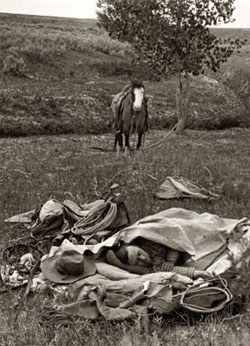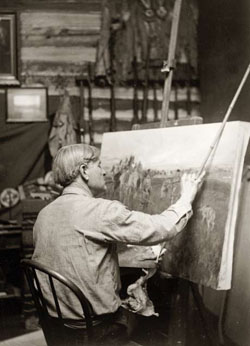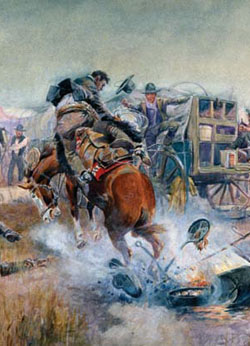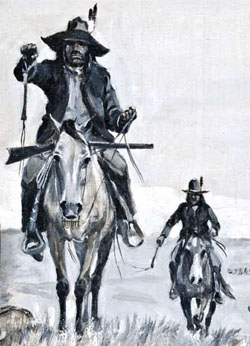Montana: Stories of the Land
Companion Website and Online Teacher's Guide
Chapter 8 - Livestock and the Open Range, 1850-1887
Chapter 1 - Montana: Where the Land Writes History
Chapter 2 - People of the Dog Days
Chapter 3 - From Dog Days to Horse Warriors
Chapter 4 - Newcomers Explore the Region
Chapter 5 - Beaver, Bison, and Black Robes
Chapter 6 - Montana's Gold and Silver Boom
Chapter 7 - Two Worlds Collide
Chapter 8 - Livestock and the Open Range
Chapter 9 - Railroads Link Montana to the Nation
Chapter 10 - Politics and the Copper Kings
Chapter 11 - The Early Reservation Years
Chapter 12 - Logging in the "High Lonesome"
Chapter 13 - Homesteading This Dry Land
Chapter 14 - Towns Have Lives, Too
Chapter 15 - Progressive Montana
Chapter 16 - Montana and World War I
Chapter 17 - Montanans on the Move
Chapter 18 - The Great Depression Transforms Montana
Chapter 19 - World War II in Montana
Chapter 20 - Building a New Montana
Chapter 21 - A People's Constitution
Chapter 22 - Living in a New Montana
Educator Resources
Educational Trunks
-
Woolies and Whinnies: The Sheep and Cattle Industry in Montana from the Montana Historical Society. This trunk reveals the fascinating stories of cattle, horse, and sheep ranching in Montana, 1870 to 1920.
-
The Grant-Kohrs Ranch Traveling Trunk, from Grant-Kohrs Ranch. This trunk focuses on cattlemen, cowboys, and cattle drives and includes period photographs, reproduction clothing, a videotape on Grant-Kohrs Ranch, books, and a teacher's guide with grade-specific activities.
Takeaways
-
Inspired by reading specialist Tammy Elser, who was in turn inspired by SKC graduate Taylor Crawford, we've created a "Takeaway" bookmark for every chapter of Montana: Stories of the Land. Before starting a chapter, print and cut out these bookmarks and distribute them to your students. Ask them to use the Takeaway to summarize the GIST of what they learn from reading assigned sections of the chapter. Remind them that they don't have much room, so they'll need to think before they write down the most important idea they want to take away from the section. Learn a little more about the GIST strategy.
-
Even though we've created Takeaways for every chapter, we don't recommend you have your students complete a Takeaway for every section of every chapter they read. That would be exceedingly tedious. However, used appropriately, they can be a useful tool for encouraging reflection and teaching students how to summarize information.
Websites and Online Lesson Plans
-
Montana's Charlie Russell was created by the Montana Historical Society to help you bring the Cowboy Artist to your classroom. It includes eight lessons aligned to the Montana Common Core, Art and Social Studies Standards; biographical PowerPoints (one designed for elementary students, the other for upper grades); and images of sixteen Russell paintings, letters, and sculptures.
-
Easily adapted to distance learning, Do You Want to Be a Cowboy/Girl? asks students to conduct guided research of primary and secondary sources to decide if they would like to have been working cowboys or cowgirls on the open range.
-
The Annotated Resource Set Livestock and the Open Range, 1850-1887 includes links to photographs, maps, illustrations, and documents relating to Montana’s early mining history. Many, but not all, of the images were also used to illustrate Chapter 8 of Montana: Stories of the Land. These sources can be used to build PowerPoints or to create DBQs or other primary-source based activities.
-
The Montana Historical Society has scanned brand records from 1873 through 1980, and has made the information available through the Montana History Portal. A thorough, and very easy to read article on decoding livestock brands is here and offers a brief history of cattle branding.
-
The website PBS created to accompany its series The West includes good general and background information on cowboys.
-
You can find primary sources on Montana's cattle and sheep industries on the Montana History Portal. See particularly the L. A. Huffman and Evelyn Cameron photographs contributed by the Montana Historical Society. See also Evelyn Cameron's diaries (and transcriptions.)
-
The Montana Historical Society has digitized its Charles M. Russell Collection, so all of its Russell artwork is now available online for viewing.
Videos or DVDs
- Ranching with Zoe Ann Stoltz - 7 minutes
-
Evelyn Cameron: Pictures from a Worthy Life - 57 minutes.
-
The Last Stronghold: The Miles City Bucking Horse Sale, Montana PBS - 30 minutes.
- Keeping the Barn - 1 hour 27 minutes
Possible Field Trips: View the Map
-
Grant-Kohrs Ranch National Historic Site, near Deer Lodge
-
C. M. Russell Museum, Great Falls
-
Montana Historical Society McKay Gallery of C. M. Russell Art, Helena
-
Range Riders Museum, Miles City
Chapter 8 Test and Answer Keys Page
The tests and answer keys are password protected.
You can contact us to receive the password:
- Martha Kohl - call (406) 444-4790 or email mkohl@mt.gov
- Melissa Hibbard - call (406) 444-4741 or email Melissa.Hibbard@mt.gov
Or, if you used the old system, the original username is now the new password. You will be asked for this case-sensitive password every time you open a new document.
Alignment to ELA Common Core Standards
Alignment to Content Standards and Essential Understandings Regarding Montana Indians (EU)




